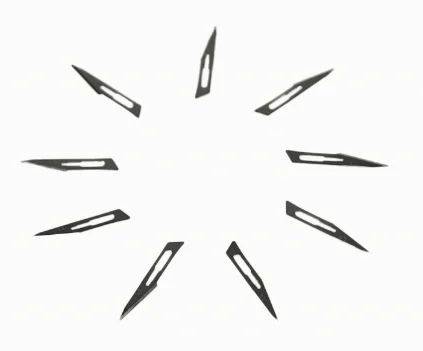

In stone age obsidian was used as a cutting tool for making any sharp tool and it is still used as a cutting tool in modern surgeries. Ceramic, titanium, diamond, sapphire, and obsidian are other less common options. Obsidian is used as a cutting tool because of its conchoidal fracturing where it breaks into thin sheets and have sharp edges. Silver was historically the material of choice for surgical scalpels, but today, surgical scalpel blades are usually made from stainless steel, tempered steel or high carbon steel.
#SURGICAL OBSIDIAN SCALPEL FREE#
FREE Shipping on orders over 25 shipped by Amazon. Individually Wrapped 11 Blade, Sterile Box of 20. Modern archaeologists have developed a relative dating system, obsidian hydration dating, to calculate the age of obsidian artefacts. MedHelp Disposable Scalpel 11, Dermaplaning Blades with Plastic Handle, High Carbon Steel Dermablade Blades. It was also polished to create early mirrors. Like all glass and some other types of naturally occurring rocks, obsidian breaks with a characteristic conchoidal fracture. Obsidian was valued in Stone Age cultures because, like flint, it could be fractured to produce sharp blades or arrowheads. The first attested civilised use is from excavations at Tell Brak dated the late fifth millennia.

Anatolian sources of obsidian are known to have been the material used in the Levant and modern-day Iraqi Kurdistan from a time beginning sometime about 12,500 BC. Use of obsidian in pottery of the Neolithic in the area around Lipari was found to be significantly less at a distance representing two weeks journeying. Q: What are the upkeeping requirements of an Obsidian knife A: Whether it’s been put to use or not Obsidian knives require care from time to time. Obsidian knife’s edge even surpasses the sharpness of a surgical scalpel by 500-1000 times. However, I fear that these methods could possibly weaken the (already delicate) structure of the obsidian.The first known archaeological evidence of usage was in Kariandusi and other sites of the Acheulian age (beginning 1.5 million years BP) dated 700,000 BC, although the number of objects found at these sites were very low relative to the Neolithic. Obsidian beats the edge of a diamond by being triple times sharper than the diamond. I have considered subjecting the scalpel to strong dose of UV radiation or perhaps 'cleaning' the scalpel with Povidone-Iodine (Betadine). I did try looking up the structure that obsidian assumes at the molecular level, with the hope that the knowledge would help me narrow down possible sterilization methods I could use here, but I drew a blank there as well. Barbers embellished their scalpels as part of the art of their trade.

As surgery became a profession, knives dedicated to specific uses also evolved. Das verhältnismäßig günstige Obsidianskalpell ist ein guter. Es ist ideal für Anwendungen, wo ein extrem feiner Schneidevorgang nötig ist oder wo keine Spurenmetalle von gewöhnlichen Skalpellklingen auftreten dürfen. The physical instruments that surgeons use today began as flint and obsidian cutting instruments during the Stone Age. Obsidian ist eine Art vulkanisches Glas, das eine viel feinere Klinge ergibt als herkömmlicher Stahl. Knowing how delicate this thing is, I doubt conventional methods (such as autoclaving it) used to sterilize surgical tools could be safely applied in this case.Īs the use of obsidian blades in surgery is relatively new, I'm not surprised that I can't find any literature dealing with the sterilization of obsidian blades online. The scalpel, one of the first surgical instruments, has evolved over more than 10 millennia. I don't actually plan on operating on someone with this, but all the same, I'd like to identify potential methods to sterilize such a blade. Now these scalpels are pretty fragile, with some of them having a thickness of the order of 0.1 mm. I recently came across this article on the use of obsidian scalpels in surgery: How Stone Age blades are still cutting it in modern surgery


 0 kommentar(er)
0 kommentar(er)
